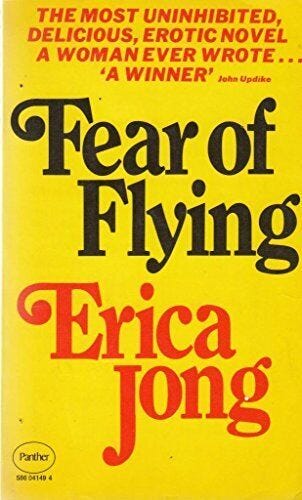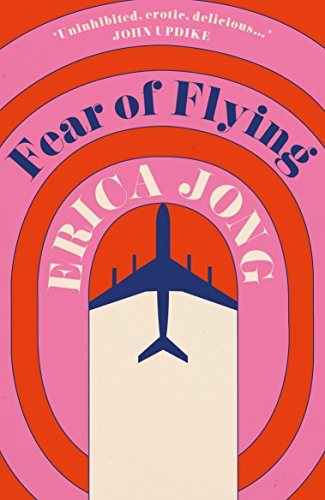Welcome to A Narrative of their Own, where I discuss the work of 20th century women writers and their relevance to contemporary culture.
I was interested to note that Erica Jong’s infamous Fear of Flying – the novel that started a conversation about a woman’s longing for the ultimate no-strings relationship – turns 50 this year.
Published in 1973, the same year as Roe-v-Wade legalised abortion in the Supreme Court, feels significant for an erotic novel featuring a young woman in search of equality in the bedroom, rather than the boardroom.
What interested me more, though, was whether the book would still seem shocking (or relevant) to today’s young women.
Jong’s opening to the novel features Isadora Duncan as she boards an aeroplane carrying 117 psychoanalysts (one of whom is her husband) to attend a conference in Vienna where she is to write a satirical feature for the magazine. (See here for the first full chapter, if you want to check out Jong’s ironic tone).
The title of the book references Isadora’s literal fear of flying – she tells us she has been treated by at least six of the analysts on board – as well as referencing the ‘flight’ she will take on this trip into the world of casual, no-strings sex.
Whilst the novel was loved by many (selling over three million copies on its paperback release in 1974) it also received some scathing reviews. Seen by many as the first of its kind and a breakthrough in what women could write about, and the open language they could use to do it, whilst by others as the collapse of moral standards. Jong uses language to describe women’s bodies and sexual acts within Fear of Flying that I don’t think you’d find in most books even now. Novelist Henry Miller helped sales along by declaring the novel destined to make literary history, but it was the word-of-mouth reviews that really made the book a bestseller, including discussions through consciousness-raising groups of the 1970’s and the uptake of the novel on University literature and sociology courses.
Released right at the centre of the rise of the feminist novel during second-wave feminism meant that Jong’s novel was ideally placed amongst many of her contemporaries. Clearly hitting the mark with many women, in a 2008 interview, Jong claimed that wherever she travelled women would come up to her and tell her that they were Isadora Wing.
But Jong took her novel into new territory within the language she used. Openly explicit (and then some) there are no thinly veiled romantic allusions to love making. Instead, the novel contains (what some might consider) openly gratuitous references to sexual yearning. This was found to be exhilarating by some women in the 1970s, many of whom sensed that Jong and her protagonist felt the way they did about topics such as marriage, commitment, independence and sex. Others however simply found the novel trashy.
This didn’t stop the book from selling (in fact I would make a guess that it enhanced sales!) Likened in more recent years to the popularity of 50 Shades of Grey (which received similarly derogatory comments around its trashy-ness), the book had sold six million copies by 1977 after being translated into twelve languages. Further success came when the novel was made available in the former Soviet republics and East European countries following the collapse of communism. At last count, sales of the book amounted to over twenty million copies.
Interestingly, many people associate the novel with Jong’s use of the term for the perfect, effortless sexual encounter: “the zipless f---”; brief, preferably anonymous, without guilt. What many might struggle to remember however is the actual plot or character development of the novel, and whether, despite all the hype of the subversive and original language used by Jong, the book actually entertains the reader.
The plot features twenty-nine-year-old Isadora Wing, author of a volume of erotic poetry, as she attends the conference in Vienna with her Chinese-American husband. Isadora is frustrated both emotionally and sexually within her marriage, though also craves the conventionality of the safety of her husband. Embarking on a frantic road trip with an analyst she meets at the conference, her pleasure lasts for just two and a half weeks, when the analyst dumps her to return to his girlfriend and children for a long-planned vacation.
The book is also padded out with reflections of Isadora’s life and Jewish upbringing, and it clearly mirrors Jong’s own biography closely. The tone of these reflections are often ironic and appear to be slightly exaggerated.
Isadora, despite looking for adventure and sexual freedom, begins at first to fall apart from this abandonment. She emerges quickly however, drawing on some of her new-found confidence and independence and heads to London, where she had previously planned to meet up with her husband in a hotel before returning together to New York. Obtaining the key to his room, she runs herself a bath and waits for his return.
The book ends with her husband entering the bathroom and the question looming as to whether Isadora will stay with him or make it alone. Either way, the conclusion is clear: with or without her marriage, she realises she will be fine.
Some critics have drawn upon the significance of the span of the novel running through a full 28-day cycle, with Isadora beginning to menstruate at the end of the book. Others have called the ending something of a ‘cop-out’ in its lack of a definite conclusion.
When I first encountered the novel around a decade ago, I had high expectations of a book that I thought would reveal the liberation of a woman’s independence. I have to say that I found the language felt more exaggerated for effect, rather than liberating. I also found Jong’s narrator a little self-absorbed and contradictory.
Whilst I could see the importance of a novel of this kind at that time (and I am all for women’s books which challenge stereotypes and show other sides to women’s feelings and yearnings), the language used in the book often feels over-done and unnecessary (to me). Whilst I don’t mind the use of bad language in literature, the crudeness of this text often felt a bit like Jong trying to shock the reader or make a point.
However, given Jong’s confirmation that female readers would often approach her to say how much they identified with Isadora Duncan, perhaps this is my own British-ness emerging! Or maybe, in the new millennium, the book doesn’t feel so urgent and necessary as it perhaps was for women in frustrating marriages or who felt stifled by convention. Perhaps in 1973, Jong’s extreme language was necessary to jolt the consciousness of both women and men into realising that women also craved the freedom to explore their bodies and relationships without recourse.
As I mentioned earlier, what interested me in considering the book’s fiftieth anniversary was what the landscape of sexual politics is like for women in 2023, as opposed to the 1970s. Would Isadora’s longing for sexual freedom outside of marriage be at all relevant to today’s society of young women, and would the language still seem shocking and subversive, or slightly cringe-inducing?
I think a lot of barriers have been broken down regarding casual relationships with the increased use of dating apps and the arrival of the ‘hook-up’, making no-strings sex an accepted choice made by both parties.
But I still think that women are seen differently – and importantly, the language used against them is different – for all our empowerment in this area. There still appears to be double standards at play, with an imbalance of power, particularly when we consider the use of images of women posted online against their consent, and the way women in the media are often referenced. For example, outspoken British ex-journalist and presenter Piers Morgan was criticised for ‘slut shaming’ former UK pop band Little Mix for their revealing clothing, whilst hugely successful singer-songwriter Taylor Swift often faces a backlash around her dating life unseen by her male contemporaries.
Thankfully, the rise of sex-positive shows has sought to redress the balance in this area. I have enjoyed several of these in recent months, including Shrill, The Bold Type, Good Trouble and Spanish series Valeria, all of which explore single women (and men) as they indulge in dating, relationships, and friendships. A benchmark for this appears to have been set with the release of Lena Dunham’s Girls back in 2012.
Sadly however, I still hear derogatory and judgemental language aimed at women who enjoy an active sex life even by other women, whereas I don’t think there are similarly derogatory words to describe men. In fact, this is sometimes seen as desirable, rather than shameful. (I also have to thank my twenty-something daughter here for her thoughts on this, which influenced my feeling that though we have come a long way, there is still far to go!)
Which brings me back to Fear of Flying, and its relevance fifty years on.
On reflection, I think that until we remove the taboos of shame from all women’s narratives, we will always need writers like Jong pushing the boundaries of what is ‘acceptable’ in order to explore these ideas in a way we can connect with.





Really enjoyed reading this as I liked that you approached it from a 1973 and 2023 perspective. It was also interesting to read about the media image of female and male celebrities and how they are certainly treat differently. A great read.
Thanks, Kate. Yet another author you’ve introduced me to. Yes... we have come far, but there is still far to go...